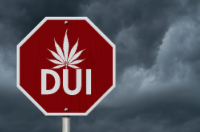It’s Saturday night and you just got pulled over. You are not drunk, but you did use cannabis — can you get a DUI? Oh yes, but… In California, prosecutors must prove that a driver not only consumed cannabis, but also that he or she was impaired at the time of driving to establish a DUI. This is no easy task.
On the Road… How Officers Determine Impairment for a Cannabis DUI
Although alcohol is easily detected through the use of breathalyzers, detecting cannabis or THC (the active component of cannabis) in your system is a bit more difficult. Without an “objective” scientific test available roadside, law enforcement officers look for “circumstantial evidence of impairment” when they suspect that a driver is driving under the influence of any substance, including cannabis.
“Circumstantial evidence” of cannabis impairment can include statements made to officers, odor of cannabis, and performance on a Field Sobriety Test (FST). Dilated pupils, slurred speech, redness of the eyes, or even a driver’s behavior can further determine impairment. The bad news – this determination is pretty subjective and discretionary.
However, these types of observations are not determinative. Drivers who are simply nervous, anxious or scared while being pulled over might portray similar symptoms and be classified as an impaired driver. Because of such a high risk of error, these cases are very hard for prosecutors to prove, but also create a large probability of false arrests. Thus, we need a more concrete way to determine if a driver is under the influence of cannabis.
The Problem with Testing for THC
If you have ever used cannabis – there are probably traces of THC in your system, but determining whether these amounts are dormant or are actually affecting your body currently is the hard part. Why? Cannabis can stay in your system for days and even weeks after it’s initially consumed. Further, studies show that THC remains in your mouth and on your breath for up to a few hours. Because it can stay on your breath, a breathalyzer can detect its presence. But, and it’s a big BUT, there is no way to determine whether a driver is actually impaired based on some measure of THC in the mouth or lungs. THC does not transport itself along the blood-brain barrier like alcohol does, so the breathalyzer that we use for alcohol does not work for cannabis!
Tests to ID THC
Blood, urine, and saliva all carry traces of THC. Blood is the most common and accurate test, but saliva tests, while not reliable or accurate, are advantageous, because they can be done roadside. This eight-minute test can detect cocaine, Xanax, methamphetamine, narcotic analgesics and THC, showing cannabis usage within the past few hours.
So what are we doing with this technology? The MMRSA passed by governor Jerry Brown in October 2015, authorized UC San Diego to research new cannabis-specific field sobriety tests. So far, UCSD is exploring the use of oral swab devices to detect THC, however, some states are launching a saliva-based drug-testing program this year.
What is the Legal Amount of THC?
Saliva tests may be the quick fix, but blood is a lot more accurate. Let’s talk numbers!
States like Oregon, Colorado, and Washington have established a THC threshold for the bloodstream. On average, these states classify “marijuana impairment” at above five (5) nanograms of active THC per milliliter of blood.
Currently, California does not have an established content limit for drivers suspected of driving under the influence of cannabis. However, California’s new Assembly Bill 2740 would establish such limit, making the impairment threshold 5ng/ml or more of THC.
The problem with this threshold is that chronic medical cannabis patients with serious illnesses such as A.I.D.S. and cancer can show 5 ng/ml in the blood for days after using cannabis. Even someone who smoked a lot on the weekend could be convicted of a DUI on Tuesday because of the levels of THC that stayed in their system, making this approach unreliable and overbroad, subjecting undeserving cannabis users to criminal prosecutions.
Possible Effects of AUMA on Cannabis DUIs
In Colorado, cannabis-related traffic deaths have increased 32%, and in Washington, fatal crashes involving drivers under the influence of cannabis doubled. Although scientific evidence is unclear as to how cannabis impairment affects driving, it seems legalized cannabis increases drivers on the road under the influence. In California, we foresee a potential for the same influx of legal issues relating to DUI arrests, especially since California will be gearing up with drug recognition experts. These officers will use all of their expertise and experience to catch this new category of impaired drivers. So, before you leave your house, think twice – to drive or not to drive?
Disclaimer: This article has been prepared and published for informational purposes only and is not offered, nor should be construed, as legal advice.

